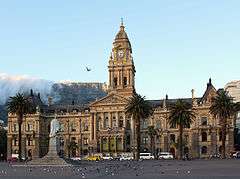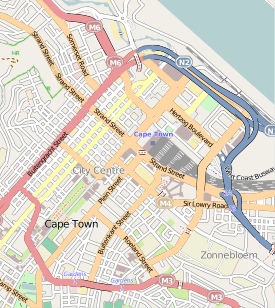Cape Town City Hall
| Cape Town City Hall | |
|---|---|
 Cape Town City Hall | |
 Location in central Cape Town | |
| General information | |
| Status | Recently restored |
| Type | City Hall |
| Architectural style | Edwardian |
| Address | Grand Parade (Cape Town) |
| Town or city | Cape Town |
| Country | South Africa |
| Coordinates | 33°55′31″S 18°25′26″E / 33.92528°S 18.42389°ECoordinates: 33°55′31″S 18°25′26″E / 33.92528°S 18.42389°E |
| Completed | 1905 |
| Renovated | TBA |
| Owner | City of Cape Town |
| Design and construction | |
| Architect | Messrs Henry Austin Reid and Frederick George Green |
| Main contractor | Messrs T. Howard and F. G. Scott |
Cape Town City Hall is a large Edwardian building in Cape Town city centre which was built in 1905. It is located on the Grand Parade to the west of the Castle and is built from honey-coloured oolitic limestone imported from Bath in England.
History
The building was designed as the result of a public competition, the winning architects being Messrs Harry Austin Reid and Frederick George Green, with the contractors being Messrs T. Howard and F. G. Scott. Much of the building material, including fixtures and fittings was imported from Europe.

The Organ was built by Messrs Norman and Beard of London and Norwich, the specifications were drawn up by Sir George Martin, organist of St Paul's Cathedral in London especially for the City Hall. The workmanship and materials are of high quality, and the organ made from mahogany, teak and pine. Sir George Martin spoke of it as “a magnificent instrument in every gradation of tone, from the softest stop to the most powerful tuba being found in the organ, and all under the most perfect control, and that altogether the instrument must be regarded as an artistic and mechanical triumph”. There are altogether 3165 pipes varying from 32 feet (10 metres) to 3⁄4 inch (19 millimetres). The wind was supplied by a Kinetic Blower worked by an electric motor.
The tower of the City Hall has a Turret Clock which strikes the hours and chimes the Westminster quarters. The faces of the clock are made from 4 skeleton iron dials filled with opal. The clock has a 24-hour wheel and lever. The bells were cast by Messrs John Taylor and Co of Loughborough and the clock was supplied by JB Joyce & Co of Whitchurch.
The City Hall's carillon was installed as a World War I war memorial, with 22 additional bells being added in 1925 with the visit of the Prince of Wales.
On February 11, 1990, only hours after his release from prison, Nelson Mandela made his first public speech after his release from the balcony of Cape Town City Hall.
Contemporary use
The City Hall has become a central venue for creative and cultural events. One of these events includes the City Hall Session.[1]
Future use
The City Hall no longer houses the offices of the City of Cape Town, which are located in the Cape Town Civic Centre. The auditorium is regularly used for concerts, while the City Library was recently moved to the adjacent Old Drill Hall. The future use and restoration of the City Hall is in 2009 under review by the City of Cape Town.
Panorama
References
- ↑ "City Hall Sessions". News 24. 6 July 2013. Retrieved 19 July 2013.
See also
 Media related to Cape Town City Hall at Wikimedia Commons
Media related to Cape Town City Hall at Wikimedia Commons- Site by City Hall, Darling Street, Cape Town , at SAHRA